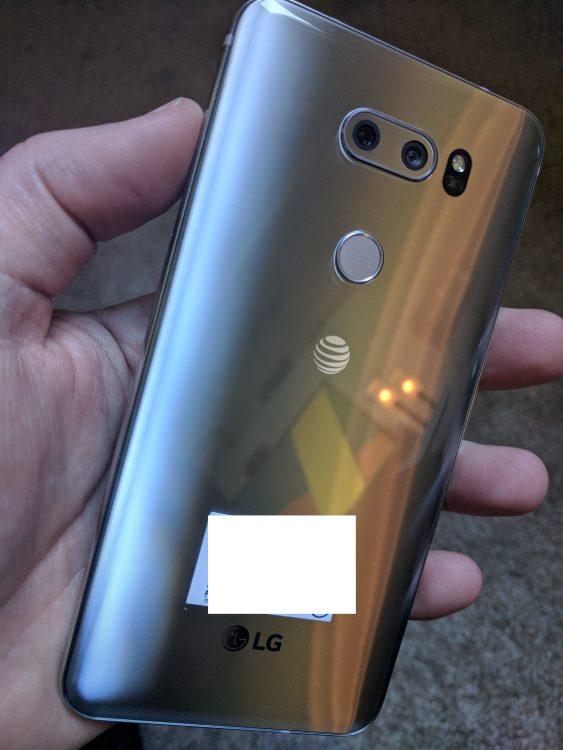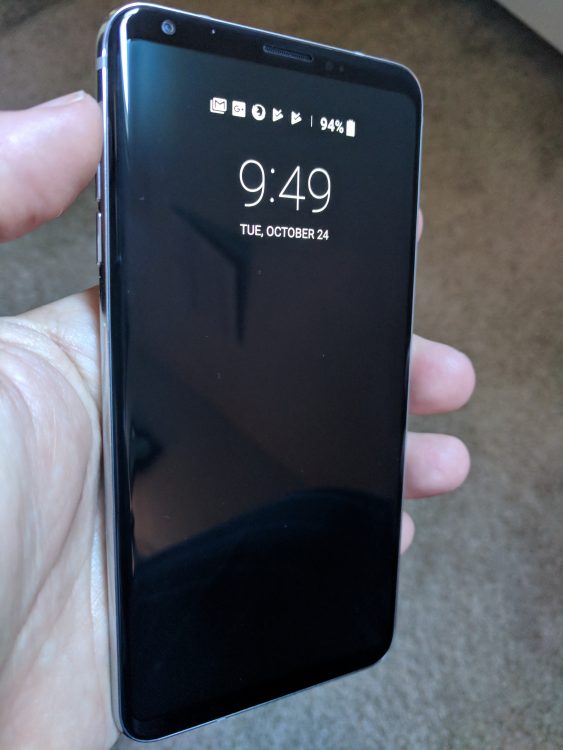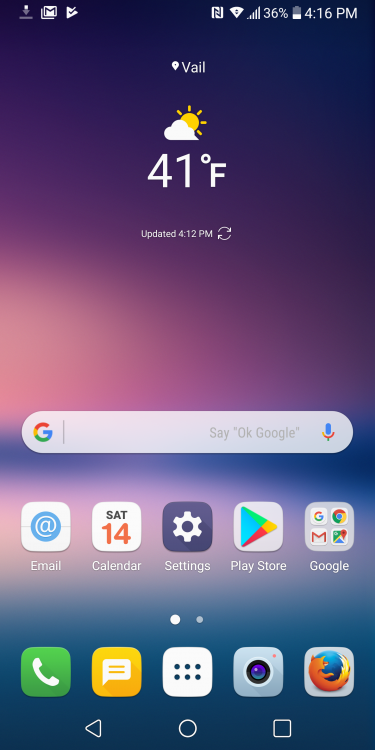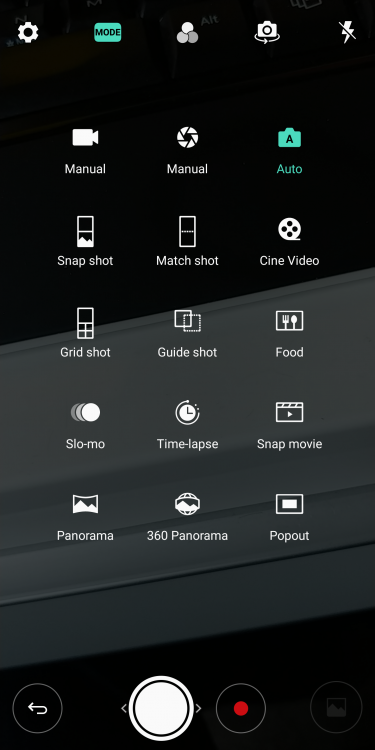A few weeks ago, Judie asked if I’d like to review the LG V30 for Gear Diary. I jumped at the chance. I’d heard many good things about LG’s latest flagship and had also read some concerns about it. But the chance to use it was on offer, and I took advantage of it.
After a few weeks, I have mixed feelings on this flagship device.

LG V30
Don’t get me wrong. The V30 is a good overall phone but it isn’t great. The display is awesome, the camera is awesome too. That said, I am not overwhelmed by the feeling of the phone. It doesn’t have the solid feel you would expect from a flagship phone.
Can I recommend it? Yes, but for the price, there may be better options out there.
Specifications
The V30 from a specifications perspective has what you would expect from a late-2017 flagship device. It is powered by the octa-core Snapdragon 835 SoC with 4×2.45 GHz Kryo & 4×1.9 GHz Kryo cores. It is coupled with the Adreno 540 GPU. The V30 comes with 4GB of RAM and 64GB of onboard storage. That storage can be expanded up to an additional 256GB thanks to the MicroSD card slot.
Like other flagship devices, the LG V30 sports an 18:9 ratio display. That resolution is 1440 x 2880 which gives a very eye comforting ~537PPI. The display is 6″, P-OLED unit and because of the nearly bezel-less design of the phone, takes up an impressive 81.9% of the front of the phone. It is curved on the sides and is protected by Gorilla Glass 5.
Physically, the phone measures 5.97 x 2.97 x .29″ or 151.7 x 75.4 x 7.4 mm in new money. It weighs in at a feather-light 5.57 ounces (158 grams). It is IP68 water and dust resistant rated, meaning it can survive up to 1.5 meters of water for 30 minutes.
From a connectivity perspective, the LG V30 sports a wide range of LTE bands. I should note that the phone that we were sent is locked to AT&T but below I have listed all of the frequencies for the unlocked variant.
- GSM 850 / 900 / 1800 / 1900
- HSDPA 850 / 900 / 1700(AWS) / 1900 / 2100
- LTE band 1(2100), 2(1900), 3(1800), 4(1700/2100), 5(850), 7(2600), 8(900), 12(700), 13(700), 17(700), 20(800), 28(700), 38(2600)
WiFi 802.11 a/b/g/n/ac is supported with a dual-band configuration and Bluetooth 5.0 is built-in to the V30 too.
The main camera of the LG V30 is a dual camera configuration. The first camera is a 16MP f/1.6 shooter with OIS and laser plus phase detection autofocus. The second camera is a 13MP f/1.9 configuration. This camera is a 120° wide-angle shooter with no autofocus. The combination of the two cameras provides some excellent photo quality which I will cover later on in this review. As for the front-facing selfie camera, it is a 5MP f/2.2 shooter that is also wide-angle. It has a 90° angle of view.
The battery is a 3300mAh lithium-polymer unit with the phone supporting Quick Charge 3.0 technology as well as wireless charging. The battery can be charged to 50% capacity in 36 minutes according to LG.
Port-wise, the LG V30 has a 3.5mm headphone jack, a dying element on phones in 2017. That port is B&O certified with excellent audio quality. The phone is charged via the single USB-C port. The phone has a fingerprint scanner that is rear mounted and has NFC capability for Android Pay support.
Finally, the LG V30 runs on Android Nougat 7.1.2 which is a bit of a disappointment. While LG has already committed to having an Oreo update out for the phone, it is a shame that it doesn’t come with it out of the box. Hopefully, this update will not be too far down the road.
On paper, the specs of this phone are rock solid. You aren’t going to find much to complain about frankly outside of the fact that the phone ships with Nougat and not Oreo. In the grand scheme of things, that’s small potatoes but it is still there. It means that the V30 will likely never see Android Q which will put it behind the new Pixel 2 lineup.
Form Factor
Turning to the form factor of the V30, it is a well-designed phone. The front of the phone is dominated by the 6″ display with the selfie camera positioned just above that display, to the right as you look at the phone. The speaker for the phone is in the center above the display. On the left edge is where you will find the volume rocker while on the right edge is where the SIM tray is located. On the bottom edge, you will find the microphone hole, the USB-C port, and the speaker.
Turning the V30 over, the smooth aluminum back is nicely designed but does have a “hollow” sound to it when you tap on it. It doesn’t feel or sound solid. In the top center of the back is where you will find the dual main cameras of the device with the flash/autofocus array to the right of them. Just below the cameras is the fingerprint scanner/power switch of the phone. Pressing and holding this button powers on the phone and tapping it turns off it off. Long pressing, while the phone is on, allows you to restart or power down the device.
While I understand LG’s desire to keep the design of the V30 clean, this combination scanner/power button feels very flimsy. It feels like a thin membrane under your finger that personally, I don’t like. I find the fixed fingerprint scanners of the Pixel lineup as well as the Huawei devices a more preferable solution.
From a fingerprint scanner perspective, it does perform flawlessly in my testing.
Despite the not-so-solid feeling (or sound) of the back, the V30 does feel good in your hand. The 6″ screen doesn’t feel huge in your hand and it’s easy to hold it and thumb operate most of the screen with one hand.
General Performance
For raw day-to-day power usage, the LG V30 isn’t going to disappoint. The Snapdragon 835 is a fantastic SoC that can easily get you through any demanding gaming task or the more likely email and web surfing throughout the day. The phone scored 1915 points on the single core test using GeekBench 4. On the multi-core test, the score was 6480. This puts it on par with the Samsung Galaxy S8, Galaxy Note8. Testing on Basemark OS II, the V30 scored 2698, which again puts it in the same area as the Samsung devices.
While benchmarking is good, the everyday use of the phone is what really matters to most readers. The V30 is great for the normal stuff you do on your phone like email, Facebook, Snapchat, and YouTube or Netflix watching. It can easily keep up with all of these activities without any feeling of lag or hesitation.
Display Performance
From a display perspective, you will be hard pressed to find one better than the P-OLED display of the V30. In a word, stunning. The color accuracy is fantastic and the high PPI makes it easy to view the 18:9 ratio screen for long periods of time. In my testing for this review, I had no problem with basic apps like Gmail rendering crisp, easy-to-read text while apps like Netflix were easy to watch thanks both to the size of the display as well as its HDR support.
A nice feature of the display is the always-on feature. If you aren’t familiar with it, this will have a low power ambient display on when the phone is powered off. You will get the date and time as well as notification icons for apps. I’m personally a big fan of these always-on displays and LG has done a good job with theirs.
Camera Performance
Another big bright spot for the LG V30 are the cameras. The rear dual-camera configuration is excellent, providing clear, crisp images both outdoors as well as indoors. Color accuracy is excellent too on both indoor and outdoor shots.
As mentioned before, the rear camera setup has one normal lens and one wide-angle lens and you can alternate between the two with a touch of the icons in the camera app (one tree for normal, three trees for wide-angle). Those same buttons are available when you are shooting video too.
LG has done an excellent job on the camera app in the V30. There are several different modes for shooting including HDR, panoramic, manual, slow motion, 360° panoramic and even a mode to make your food shots look awesome. The Cine-Video mode allows you to create smooth zooming of your videos (think Ken Burns style) that is really a lot of fun to use.
The camera app also has several different filters that you can use to augment your photos. These include things like a sepia look, black & white and vivid colors.
As for the selfie camera, it too is rock solid. It has different filters available too as well as skin tone and lighting enhancements to get the most out of it.
User Experience
From a user experience perspective, LG leverages its own UX 6 as the V30’s launcher. It uses square icons and supports app shortcuts found in the underlying Nougat 7.1.2 build that the phone runs. There are three different modes you can use the UX 6 launcher in: A Home screen with all of your installed apps or a Home screen with an app drawer that is more traditional to Android devices. There is also a third, EasyHome mode with large fonts.
Overall the launcher is solid with no real issues other than it does take a toll on the battery. I noticed significantly better battery performance when I moved to Google Now or Nova Launcher over the stock launcher.
I should note that the model we were sent to review was locked to AT&T. That means it did have some AT&T apps pre-installed as well as some other bloatware apps. I’m not a big fan of carrier locked phones so if you can afford to go unlocked, do it. It will be a bit more pure in the experience and you will get updates faster.
Battery Performance
The battery performance of the LG V30 is solid and will get you through the day. As I mentioned above, if you are willing to change the launcher of the phone, you will get a bump in performance by doing so. But even without doing this, you should be able to make it throughout the day on a charge doing the normal things like Email, web surfing, a little bit of YouTube and Netflix.
Conclusion & Recommendation
Overall, I don’t have a problem recommending the LG V30. It is a good, solid phone from a performance and display perspective. The display is outstanding and photo quality is equally outstanding. My biggest reservation is the back of the phone. It feels flimsy. That may sound nitpicky but when you are spending $800 on a phone, I don’t think I’m overreacting.
Is it a deal breaker? Probably not. The reality is that you will likely have your V30 in a case, in which this becomes moot.
The LG V30 retails for $809, and it is available through a variety of carriers here in the US.
Source: Manufacturer supplied review sample locked to AT&T
What I Like: Overall performance; Camera performance (outstanding!); Display
What Needs Improvement: Back of the phone feels “hollow”












